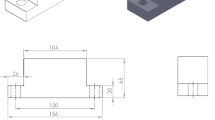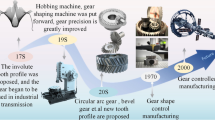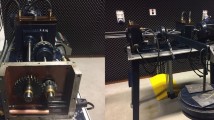Abstract
The traditional finishing method causes form inaccuracy in miniature gear profiles due to the transverse grinding line, fine microcrack, claw-mark, burr, pit and thermal distortions. Because of the small space between their teeth, tiny gear can only be polished in a very few ways. This article reports on the new flow restrictor used in rotational-magnetorheological miniature gear profile polishing (R-MRMGPP) process for precise polishing of miniature gear profiles. The response surface method (RSM) is utilized to investigate the effect of key factors on process performance. Further, simulation of finishing forces is conducted using COMSOL® Multiphysics software, which is based on finite element analysis (FEA). The study of finishing forces assists in accurately understanding the processing mechanism. A model is also simulated to determine the depth of indentation produced by an abrasive on SS316L miniature gear tooth profile due to normal finishing forces. Experimental results identified that combining a higher number of finishing cycles, a lower volumetric proportion of iron/abrasive particles, and a higher extrusion pressure is more favourable to obtain high material removal rate (MRR).















Similar content being viewed by others
Abbreviations
- B :
-
Magnetic flux density (MFD) (T)
- B (x) :
-
MFD variation in work gap (x) (T)
- D g :
-
Abrasive particles (APs) diameter (μm)
- F a :
-
Axial force (N)
- F c :
-
Centrifugal force (N)
- F m :
-
Normal magnetic force (N)
- F t :
-
Tangential force (N)
- H 0 :
-
Magnetic field strength (A/m)
- M :
-
Iron particles (IPs) magnetization (A-m2/Kg)
- m AP :
-
APs mass (kg)
- m ip :
-
IPs mass (kg)
- M s :
-
Saturation magnetization (A-m2/Kg)
- N :
-
Number of finishing cycles
- P :
-
Extrusion pressure (bar)
- r :
-
Distance of an AP from centre (m)
- v :
-
MRPF APs axial velocity (m/s)
- V :
-
Vol. ratio of IPs/APs
- S:
-
Magnet rotational speed (rpm)
- \(\chi_{m}\) :
-
IPs magnetic susceptibility (m3/kg)
- τ :
-
MRPF shear strength (kPa)
- \(\dot{\gamma }\) :
-
Shear rate
- v ip :
-
IPs Vol. fraction
- η :
-
Non-Newtonian viscosity (kg/(m s))
- μ 0 :
-
Magnetic permeability of free space (Wb/A m)
- ω :
-
Angular velocity (rad/s)
References
Davis JR (2005) Gear materials, properties, and manufacture. ASM International, Materials Park, OH, pp 500–600. ISBN - 0871708159
Fujisawa Y, Komori M (2010) Method for removing burrs and pits from small gears using a gear-shaped tool composed of glass-fiber-reinforced plastic. J Mater Process Technol 210:1159–1170. https://doi.org/10.1016/j.jmatprotec.2010.02.025
Kawasaki Y, Shinoda M, Nojiri S et al (1984) Development of a new automatic gear selecting machine for automobile transaxle manufacturing. CIRP Ann 33:363–368. https://doi.org/10.1016/S0007-8506(07)61443-7
Ahmad S, Anant S, Singh K, Kumar S (2020) Experimental analysis of magnetorheological finishing of blind hole surfaces using permanent magnet designed tools. J Brazilian Soc Mech Sci Eng 42:1–23. https://doi.org/10.1007/s40430-020-2225-6
Kataria M, Mangal SK (2019) Development of continuous flow magnetorheological fluid finishing process for finishing of small holes. J Brazilian Soc Mech Sci Eng 41:1–13. https://doi.org/10.1007/s40430-019-2027-x
Das M, Jain VK, Ghoshdastidar PS (2012) Nanofinishing of flat workpieces using rotational–magnetorheological abrasive flow finishing (R-MRAFF) process. Int J Adv Manuf Technol 62:405–420. https://doi.org/10.1007/s00170-011-3808-2
Jain NK, Ramlal Naik L, Dubey AK, Shan HS (2009) State-of-art-review of electrochemical honing of internal cylinders and gears. Proc Inst Mech Eng Part B J Eng Manuf 223:665–681. https://doi.org/10.1243/09544054JEM1381
Mayer JE, Price AH, Purushothaman GK et al (2002) Specific grinding energy causing thermal damage in helicopter gear steel. J Manuf Process 4:142–147. https://doi.org/10.1016/S1526-6125(02)70140-0
Jolivet S, Mezghani S, El Mansori M et al (2017) Experimental study of the contribution of gear tooth finishing processes to friction noise. Tribol Int 115:70–77. https://doi.org/10.1016/j.triboint.2017.05.004
Klocke F, Löpenhaus C, Sari D (2016) Process concepts for gear finish hobbing. Procedia CIRP. Elsevier B.V, Amsterdam, pp 875–880
Tönshoff HK, Friemuth T, Marzenell C (2000) Properties of honed gears during lifetime. CIRP Ann Manuf Technol 49:431–434. https://doi.org/10.1016/S0007-8506(07)62982-5
Wei BY, Deng XZ, Fang ZD (2007) Study on ultrasonic-assisted lapping of gears. Int J Mach Tools Manuf 47:2051–2056. https://doi.org/10.1016/j.ijmachtools.2005.11.003
Yi J, Ding Y, Zhao S et al (2009) A novel technique of polishing gear working surface using PECMP. Int J Precis Eng Manuf 10:57–62. https://doi.org/10.1007/s12541-009-0071-7
Venkatesh G, Sharma AK, Kumar P (2015) On ultrasonic assisted abrasive flow finishing of bevel gears. Int J Mach Tools Manuf 89:29–38. https://doi.org/10.1016/j.ijmachtools.2014.10.014
Kenda J, Pušavec F, Kopac J (2014) Modeling and energy efficiency of abrasive flow machining on tooling industry case study. Procedia CIRP 13:13–18. https://doi.org/10.1016/j.procir.2014.04.003
Ali P, Walia RS, Murtaza Q, Singari RM (2020) Material removal analysis of hybrid EDM-assisted centrifugal abrasive flow machining process for performance enhancement. J Brazilian Soc Mech Sci Eng 42:1–28. https://doi.org/10.1007/s40430-020-02375-6
Ravi Datt Yadav AKS (2019) A novel magnetorheological gear profile finishing with high shape accuracy. Int J Mach Tools Manuf 139:75–92. https://doi.org/10.1016/j.ijmachtools.2019.02.001
Fujisawa Y, Komori M (2015) Surface finishing method for tooth flank of heat-treated surface-hardened small gears using a gear-shaped tool composed of alumina-fiber-reinforced plastic. Precis Eng 39:234–242. https://doi.org/10.1016/j.precisioneng.2014.10.003
Kumar M, Yadav HNS, Kumar A, Das M (2021) An overview of magnetorheological polishing fluid applied in nano-finishing of components. J Micromanufacturing 3:1–19. https://doi.org/10.1177/25165984211008173
Das M, Jain VK, Ghoshdastidar PS (2010) Nano-finishing of stainless-steel tubes using rotational magnetorheological abrasive flow finishing process. Mach Sci Technol 14:365–389. https://doi.org/10.1080/10910344.2010.511865
Shaw MC (1971) A new theory of grinding. In: Proceedings of the institution’s conference on production science in industry, pp 5–4
Stradling AW (1993) The physics of open-gradient dry magnetic separation. Int J Miner Process 39:1–18. https://doi.org/10.1016/0301-7516(93)90048-F
Kumar M, Kumar V, Kumar A et al (2021) CFD analysis of MR fluid applied for finishing of gear in MRAFF process. Mater Today Proc 25:1–7. https://doi.org/10.1016/j.matpr.2021.01.116
Tao R (2001) Super-strong magnetorheological fluids. J Phys Condens Matter, 13. https://doi.org/10.1088/0953-8984/13/50/202
Barman A, Das M (2017) Simulation of Magnetic Field Assisted Finishing (MFAF) process utilizing smart MR polishing tool. J Inst Eng Ser C 98:75–82. https://doi.org/10.1007/s40032-016-0235-z
Panneerselvam PVSK, Haq AN (2021) A comparative assessment in sequential μ-drilling of Hastelloy—X using laser in combination with μ-EDM and μ-ECM. J Brazilian Soc Mech Sci Eng 43:1–19. https://doi.org/10.1007/s40430-021-03068-4
Puri DBMYM (2020) Optimized curved electrical discharge machining-based curvature channel. J Brazilian Soc Mech Sci Eng 42:1–13. https://doi.org/10.1007/s40430-019-2162-4
Ginder JM, Davis LC, Elie LD (1996) Rheology of magnetorheology fluids: models and measurements. Int J Mod Phys 10:11
Khan NA, Sultan F (2018) Numerical analysis for the Bingham—Papanastasiou fluid flow over a rotating disk. J Appl Mech Tech Phys 59:638–644. https://doi.org/10.1134/S0021894418040090
Huang J, Zhang JQ, Liu JN (2005) Effect of magnetic field on properties of MR fluids. Int J Mod Phys B 19:597–601
Paswan SK, Singh AK (2019) Analysis of surface finishing mechanism in a newly developed rotational magnetorheological honing process for its productivity improvement. Wear 426–427:68–82. https://doi.org/10.1016/j.wear.2019.01.001
Khan DA, Jha S (2018) Synthesis of polishing fluid and novel approach for nanofinishing of copper using ball-end magnetorheological finishing process. Mater Manuf Process 33:1150–1159. https://doi.org/10.1080/10426914.2017.1328112
Acknowledgements
We acknowledge the Science & Engineering Research Board (SERB), New Delhi, India, for their financial support for project No. EEQ/2017/000597 entitled "Fabrication of Prosthetic Im-plants and further Nanofinishing using Magnetic Field Assisted Finishing (MFAF) Process".
Author information
Authors and Affiliations
Corresponding author
Additional information
Technical Editor: Izabel Fernanda Machado.
Publisher's Note
Springer Nature remains neutral with regard to jurisdictional claims in published maps and institutional affiliations.
Rights and permissions
About this article
Cite this article
Kumar, M., Das, M. & Yu, N. Effect of optimum process parameters on material removal in rotational-magnetorheological miniature gear profile polishing (R-MRMGPP) process. J Braz. Soc. Mech. Sci. Eng. 44, 205 (2022). https://doi.org/10.1007/s40430-022-03515-w
Received:
Accepted:
Published:
DOI: https://doi.org/10.1007/s40430-022-03515-w




